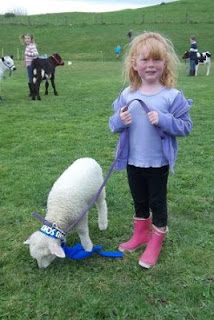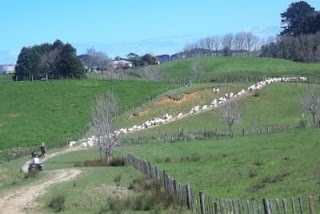We then bought home all our terminal ewes and lambs on Friday 16th ... a slow walk up the road but luckily the day wasn't too hot.
We then drafted off what looked like big lambs and weighed these over the scales on the Saturday and crutched whatever needed crutching. Saturday was one of those days when we were grateful that we had invested in some covered-in yards, as the day deteriorated into rain ... not that we were complaining because we were in need of our 21 mls. The roof overhead, certainly made working in the rain much more enjoyable.
We managed to get the job done and washed up in time to welcome our dinner guest!
Sunday morning we were up 5.30am, mustered in the ewes and lambs and drafted off all the marked lambs. We had only contract booked 200 lambs, but in reality we should have booked around 350! Terminal lambs had done better than planned. Despite our contract numbers going up each year, we are still underestimating what we can achieve. The average weaning weight of our terminal lambs was 32 kg which means half of our lambs could have been killed off mum! Pretty good going for us!
By 7.00 am the 223 lambs were winging there way to Te Kuiti Meats (with 2 other loads to pick up on the way).
Monday we weighed all the lambs and weaned everything in the terminal mob. The ewes had to sit round home until Friday 24th for shearing, so the holding paddocks are well eaten out. We shore the terminal ewes and went through and culled all the old girls (the original ewes purchased in 2008). Some of them were 6, 7 and 8 years old. A handful (approx 50) have had a second chance if in good condition and good udder as we haven't quite got enough replacements to get rid of all. All the 'keepers' were taken back down the road, whilst the 'culls' had to wait till this morning for their terminal ride. Not enough space at the works, so with 150 gone, another 100 to go.
Then inbetween we have weaned, tagged, weighed and crutched (only dirties), all our maternal ewes and lambs. Some weaning was good and some wasn't. The 2-tooth mobs weaned 29kg average, whilst our maternal twins did worse at 26 kg, and singles at 30kg. Overall average 28kg. There will be a bit of tweaking to that as some of our male lambs came through twice and haven't sorted the files out yet. I also have yet to revise our lambing % based on lambs weaned to ewes scanned due to the extras tagged at weaning. Need a rainy quite day to catch up!
Despite all that, another 160 lambs left this morning bound for Te Kuiti. It was up at 5.00am to get the lambs drafted off the ewes to meet the 6.30am truck. We were all loaded and truck departing by 7.30am.
The first lambs (terminal) didn't yield as well as would have liked - 45%, down 1-2% for milk lambs. The black faces did 16.9 kg CW and the white faces did 16.4 kg CW.
 |
| Weaned ewes and ewe lambs this morning |
 |
| Couldn't resist - Alice with two goats who had made their home between the press boxes! |
Next jobs lined up are drenching the works lambs and sorting into 2 lines based on weight, weaning our hoggets and shearing all hoggets.














.jpg)








